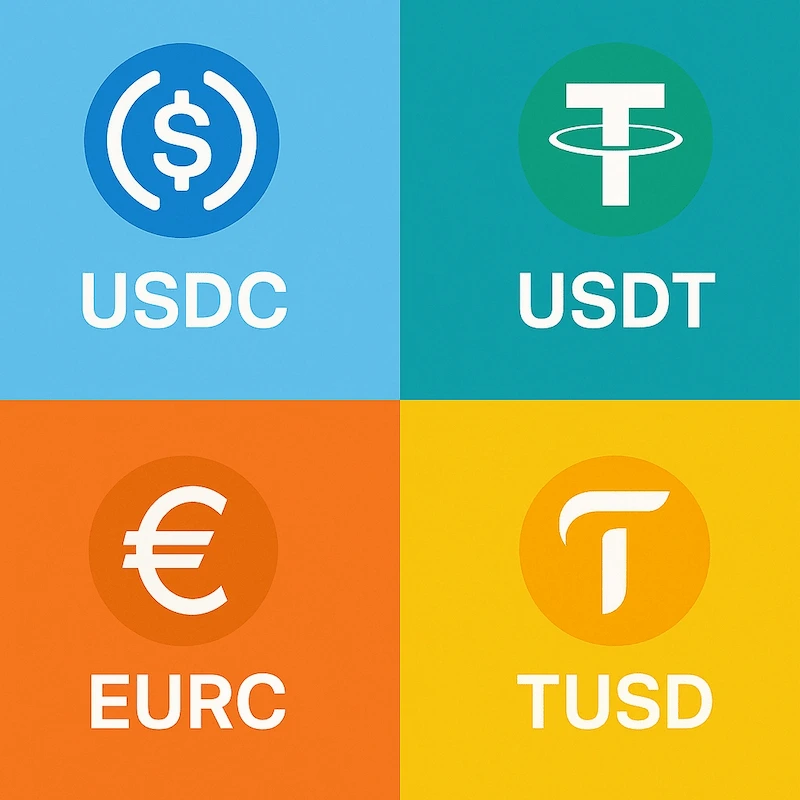
The $40B Collapse That Changed Crypto Forever
How the collapse of Terra's UST reshaped the conversation around stablecoins, trust, and the future of digital currencies.
TL;DR
- •Terra's UST algorithmic stablecoin collapsed in May 2022, erasing $40 billion in value. It relied on code and game theory (no reserves, no collateral), triggering a death spiral when panic withdrawals overwhelmed the mechanism.
- •Three stablecoin types: Fiat-backed (USDC/USDT backed by cash/Treasuries), crypto-backed (DAI overcollateralized 150%+ with ETH), algorithmic (UST - most now avoid this failed model entirely).
- •USDC is most transparent with U.S. oversight and regular attestations. USDT ($127B in U.S. Treasuries) is most traded but less transparent. Do Kwon pleaded guilty to fraud charges in 2025.
- •CBDCs offer perfect stability as actual fiat (not pegged, but issued by central banks) - but enable programmable money where governments can track, limit, or reverse every transaction.
No agenda. No noise. Just clarity.
Get the MCMS brief - digital assets, AI, and law explained with evidence, not hype.
Join 1,000+ professionals. Unsubscribe anytime.
Not All Stablecoins Are Stable
You've heard the term. But have you ever asked what keeps a "stablecoinA cryptocurrency pegged to a stable asset, such as USD or gold" stable? Stablecoins were supposed to be crypto's answer to volatility. Instead, one of them erased $40 billion in days. Here's the story behind stablecoins, and what happened.
Why No One Wanted to Get Paid in Bitcoin
BitcoinThe first decentralized cryptocurrency, created in 2009 by Satoshi Nakamoto moves like a rollercoaster. EthereumA decentralized blockchain platform that enables smart contracts and decentralized applications too. That's fine for speculation - but terrible for payments, contracts, or anything that needs price stability. Just like real world inflation cuts your purchasing power - ask anyone in Venezuela or Turkey. So stablecoins were created. To solve one of crypto's biggest problems: volatility.
The idea was to have a crypto asset pegged to the value of a real-world currency - usually the U.S. dollar - that would promise something familiar and predictable. But pegged doesn't always mean backed by that currency in a vault, like the US dollar used to be backed by gold . . . until it wasn't. Some stablecoins are supported by real reserves. Others rely on code, incentives, or a complex system of swaps.
In the end, it's all about trust - and whether that trust holds in moments of panic. As long as users trust the system, the peg holds. But if that trust breaks - and too many people try to cash out at once - the result isn't just volatility. It's a stablecoinA cryptocurrency pegged to a stable asset, such as USD or gold panic bank run. And in that scenario, even a $1 coin can go to zero - fast.

Stable on the Surface. Wild Underneath.
Stablecoins are crypto assets meant to holdA misspelling of 'hold,' used to mean holding onto cryptocurrency for long-term gains a steady value - usually $1. But how do they stay stable? That's where things get interesting.
Fiat-Backed (e.g. USDC, USDT, EURC, TUSD)
These stablecoins are pegged to fiatTraditional government-issued currency, such as USD, EUR, or NIS (usually USD or EUR) and claim to be backed by real-world assets like cash or short-term Treasuries.
- USDCA fully-reserved stablecoin pegged 1:1 to the US Dollar, issued by Circle and backed by regulated financial institutions (by Circle) is considered the most transparent and regulated, with regular attestations and U.S. oversight.
- USDTThe largest stablecoin by market cap, pegged 1:1 to the US Dollar and issued by Tether Limited (Tether) is the most traded but less transparent - backed by a mix of assets and historically slow to disclose reserves.
- EURC (formerly Euro CoinEuro-backed stablecoin issued by Circle maintaining 1:1 parity with EUR) is Circle's euro-pegged version, slowly gaining traction in Europe.
- TUSDA fiat-backed stablecoin pegged 1:1 to the US Dollar with independent attestations of its reserves is another USD-pegged coin gaining popularity in Asia, particularly on Binance pairs.
Crypto-Backed (e.g. DAI, sUSD)
These are overcollateralized with crypto - for example, DAIA decentralized, algorithmic stablecoin pegged to the US Dollar and backed by crypto collateral through the MakerDAO protocol is backed by ETHA decentralized blockchain platform that enables smart contracts and decentralized applications and other tokens locked in smart contractsSelf-executing code on a blockchain that automates transactions via MakerDAO.
- More decentralized than fiatTraditional government-issued currency, such as USD, EUR, or NIS-backed coins.
- But exposed to crypto market swings.
- Often require 150%+ collateral to mint $1 worth of stablecoinA cryptocurrency pegged to a stable asset, such as USD or gold.
Algorithmic (e.g. UST, USDN, AMPL)
These rely on code and game theory to maintain their peg.
No real reserves.
No collateral.
Just incentives.
- UST (Terra) is the most famous failure - it lost its peg in 2022, wiping out $40B.
- Other algorithmic coins (like USDN) have also collapsed or depegged.
- Most serious projects now avoid this model entirely.
The $40B that evaporated
In May 2022, the crypto world witnessed a seismic event: the collapse of Terra's UST stablecoinA cryptocurrency pegged to a stable asset, such as USD or gold. This wasn't just another market dip - it was a dramatic unraveling that erased over $40 billion in value and sent shockwaves through the entire digital asset ecosystem.
UST was designed as an algorithmic stablecoinA cryptocurrency pegged to a stable asset, such as USD or gold, aiming to maintain a 1:1 peg with the U.S. dollar through a complex mechanism involving its sister tokenA digital asset built on an existing blockchain, often representing utility or value, LUNA. The system relied on minting and burningThe process of permanently removing cryptocurrency from circulation to reduce supply LUNA to stabilize UST's price. A delicate, complicated balance - like a house of cards. The moment the first gust of doubt hit, fear spread, and the whole thing collapsed. Panic triggered massive withdrawals the mechanism couldn't handle, leading to a downward spiral. As UST lost its peg, both UST and LUNA's value evaporated.
The collapse was so significant that it drew widespread media attention. As reported by The Guardian on May 13, 2022, the event prompted major crypto exchanges to delist TerraUSD, effectively eliminating the project.
This incident served as a starkCryptographic proof system providing transparent, scalable zero-knowledge proofs without trusted setup reminder of the vulnerabilities inherent in algorithmic stablecoins and underscored the importance of robust, transparent mechanisms to maintain stability in the volatile world of cryptocurrency.
“"Stablecoins are often compared by technical specs - but sometimes, metaphors work better. Think of stablecoins like bridges. USDCA fully-reserved stablecoin pegged 1:1 to the US Dollar, issued by Circle and backed by regulated financial institutions is a bridgeA connection between two blockchains that allows the transfer of assets or data made of steel, with bank inspectors. DAIA decentralized, algorithmic stablecoin pegged to the US Dollar and backed by crypto collateral through the MakerDAO protocol is a suspension bridge made of crypto cables. Terra was… matchsticks and vibes."

Pro Tip
Don't just look at the peg - look at the redemption engine. Can the stablecoinA cryptocurrency pegged to a stable asset, such as USD or gold actually be redeemed for fiatTraditional government-issued currency, such as USD, EUR, or NIS? Who controls that process? What happens in a liquidityThe ease with which an asset can be bought or sold without affecting its price crunch?
The peg is the illusion. Redemption is reality.
Where Stablecoins Fit In the Bigger Picture
- Coins vs. Tokens: Coins (like Bitcoin or ETH) are native to their own blockchain. Tokens are built on top of existing blockchains using smart contracts. → Stablecoins are tokens, not coins. Most are issued on blockchains like Ethereum (as ERC-20 tokens), Solana, or BNB Chain - meaning they don't have their own chain, but live on others.
- On the Blockchain: Stablecoins live on blockchains for transparency, programmability, and 24/7 global transfers. Every transaction is recorded publicly - but the backing is off-chain (e.g. Treasuries, dollars in a bank). That's why they're called "blockchain-based representations of fiat." → The peg is on-chain. The backing is off-chain. The trust lives in between.
- Why It Matters: Stablecoins let users interact with DeFi, NFTs, games, and cross-border transfers - without being exposed to crypto's wild price swings. They're also the on-ramp and off-ramp layer for most users, connecting the fiat world to the crypto ecosystem.
So, is there no solution to this stability and trust issue?
Like the proverbial chicken-and-egg loop - volatility kills adoption, but without adoption, trust never builds.
There might be one.
Central Bank Digital Currencies (CBDCs) sound like the perfect fix. No volatility. No redemption risk. No shady reserves. Unlike stablecoins, they're not pegged to fiatTraditional government-issued currency, such as USD, EUR, or NIS - they are fiat. Issued and guaranteed by the state.
In theory, they offer everything crypto has been chasing: Trust, transparency, and stability - without volatility or middlemen.
But here's the cost.
With CBDCs, every transactionA transfer of value or data recorded on a blockchain, verified by network participants, and permanently added to the distributed ledger can be tracked, limited, or reversed. Money becomes programmable - not just by code, but by policy. Want to spend your digital dollars on something off script? They might not go through. Too much red meat this month? Too much travel? Too political?
It's the most stable currency you've ever used - until it doesn't let you use it.
Next Up
Crypto isn't dead. It's just maturing. While everyone in the West debates regulation and watches charts, real-world asset tokenizationConverting real-world assets into digital tokens on a blockchain is already happening, especially in emerging markets. The use cases are real, the rails are built, and some of the smartest builders are bypassing Wall Street entirely.
If you read this far, you're already ahead of most professionals.
Join 1,000+ readers who get institutional-grade insights - clear, concise, and verifiable.
No spam. Unsubscribe anytime.
If you found this useful, please share it.
Questions or feedback? Contact us
MCMS Brief • Classification: Public • Sector: Digital Assets • Region: Global
References
- 1. Harvard Law School Forum on Corporate Governance - “Anatomy of a Run: The Terra Luna Crash” (May 22, 2023) [Link]
- 2. MIT Sloan School of Management - “Anatomy of a Run: The Terra Luna Crash” (January 1, 2023) [Link]
- 3. U.S. Department of Justice - “Do Kwon Pleads Guilty to Fraud” (August 13, 2025) [Link]
- 4. Forbes - “The Death Spiral: How Terra's Algorithmic Stablecoin Came Crashing Down” (May 17, 2022) [Link]
- 5. Bloomberg - “Crypto Exchanges Start to Suspend Terra Tokens After Meltdown” (May 13, 2022) [Link]
- 6. Federal Reserve Board - “Runs on Algorithmic Stablecoins: Evidence from Iron, Titan and Steel” (June 2, 2022) [Link]
- 7. Circle - “Circle – USDC Transparency” (January 1, 2025) [Link]
- 8. Terminal 3 - “How Controversy from Day One Didn't Stop Tether” (January 1, 2024) [Link]
- 9. Tether - “Tether Attestation Report: $127B in U.S. Treasuries” (July 15, 2025) [Link]
- 10. CoinDesk - “How Does MakerDAO Work?” (March 15, 2024) [Link]
- 11. arXiv - “Stablecoin Stability Analysis: The Case of Dai” (February 1, 2024) [Link]
- 12. Bank for International Settlements - “Stablecoins: Risks, Potential and Regulation” (January 1, 2023) [Link]
- 13. CoinDesk - “UK Government Proposes Stablecoin Safeguards After Terra Collapse” (May 31, 2022) [Link]
- 14. OECD - “Central Bank Digital Currencies and Democratic Values” (July 1, 2023) [Link]
- 15. Atlantic Council - “CBDC Tracker” (January 1, 2025) [Link]
- 16. European Securities and Markets Authority - “Markets in Crypto-Assets Regulation (MiCA)” (December 30, 2024) [Link]
SOURCE FILES
Source Files expand the factual layer beneath each MCMS Brief — the verified data, primary reports, and legal records that make the story real.
The Terra/UST Collapse: Anatomy of a $40 Billion Bank Run
Terra's UST algorithmic stablecoin collapsed in May 2022, erasing approximately $40-45 billion in market capitalization within days. Harvard Law School and MIT Sloan co-authored comprehensive research documenting this as the first major crypto bank run, driven not by targeted manipulation but by growing sustainability concerns about the Anchor Protocol's unsustainable 20% APY. The collapse mechanism was a classic death spiral: UST losing its $1 peg triggered massive LUNA minting to stabilize the peg, causing hyperinflation from 500 million to 6 trillion LUNA coins. Forbes documented how 75% of UST supply ($14B of $18.7B) was concentrated in Anchor Protocol, creating systemic fragility. MIT research shows sophisticated investors exited first with smaller losses, while retail investors suffered disproportionately. The U.S. Department of Justice confirmed in August 2025 that Do Kwon pleaded guilty to fraud charges related to the collapse. Major exchanges including Binance delisted Terra tokens on May 13, 2022, as reported by Bloomberg, effectively eliminating the project. The Federal Reserve published analysis of algorithmic stablecoin failures, documenting the June 2021 Iron Finance TITAN collapse (from $60 to $0 in hours, $2B in losses) as the first major DeFi bank run, establishing patterns that would repeat with Terra.
Stablecoin Mechanisms: Fiat-Backed, Crypto-Backed, and Reserve Transparency
Stablecoins maintain their dollar peg through three distinct mechanisms, each with different trust models and failure modes. Fiat-backed stablecoins (USDC, USDT) claim backing by cash and short-term U.S. Treasuries. Circle's USDC undergoes monthly attestations by Deloitte & Touche LLP following AICPA standards, operates under U.S. regulation with licenses in 48 states including NYDFS BitLicense, and became publicly traded in 2025 subject to SEC disclosure requirements. Tether (USDT) holds $127 billion in U.S. Treasuries but faced a $41 million CFTC fine in 2021 for misleading statements about reserves - investigations found Tether sometimes held no reserves backing its dollar peg, with only 74% backed by cash equivalents at certain points. Crypto-backed stablecoins like DAI (MakerDAO) require 150%+ overcollateralization with crypto assets locked in smart contracts. CoinDesk documents how DAI uses Collateralized Debt Positions with automated liquidation if collateral drops below thresholds. Academic research (arXiv) confirms DAI's stability depends on sufficient overcollateralization ratios and market belief in the system. The Bank for International Settlements published comprehensive analysis of stablecoin risks, noting that reserve-backed models face liquidity risk during market stress, while algorithmic models lack fundamental stabilization mechanisms and are inherently fragile during confidence crises.
Regulation and CBDCs: The Programmable Money Question
Terra's collapse prompted immediate regulatory responses globally. The UK Treasury released consultation papers in May 2022 specifically citing Terra as evidence for stablecoin regulation urgency, as reported by CoinDesk. The EU's Markets in Crypto-Assets Regulation (MiCA) established comprehensive rules for stablecoin issuers, distinguishing asset-referenced tokens, e-money tokens, and utility tokens with specific compliance requirements via ESMA. Central Bank Digital Currencies emerged as the regulatory alternative to private stablecoins. The Atlantic Council's CBDC Tracker monitors 134 countries researching CBDCs, with Bahamas, Jamaica, and Nigeria having launched versions. Unlike stablecoins pegged to fiat, CBDCs are fiat - issued and guaranteed by central banks. However, the OECD published analysis warning that CBDCs could enable governments to 'monitor and track all transaction and financial activity details' with potential for unjust censorship without due process. Their report on CBDCs and democratic values identifies surveillance risks where authorities' access could lead to state-level monitoring threatening civil liberties. Programmable money raises questions about authorities imposing restrictions on usage - tracking, limiting, or reversing transactions based on policy rather than just code.
KEY SOURCE INDEX
- ●Harvard Law School Forum on Corporate Governance — Co-authored research documenting Terra as first major crypto bank run with $40-45B in losses
- ●MIT Sloan School of Management — Academic analysis showing sophisticated investors exited Terra first, retail investors suffered disproportionately
- ●U.S. Department of Justice — Official announcement of Do Kwon's guilty plea to fraud charges in August 2025
- ●Federal Reserve Board — Research paper analyzing algorithmic stablecoin bank runs including Iron Finance and Terra patterns
- ●Bank for International Settlements — Comprehensive analysis of stablecoin risks, reserve liquidity, and algorithmic fragility
- ●OECD — Report on CBDCs and democratic values, warning of surveillance risks and transaction control
- ●Circle — USDC issuer's transparency documentation including monthly Deloitte attestations and regulatory compliance
- ●Atlantic Council — CBDC Tracker monitoring 134 countries researching central bank digital currencies
- ●European Securities and Markets Authority — EU regulator implementing MiCA framework for stablecoin regulation post-Terra collapse
Related Reading
- →
Coin vs. Token - What's the Difference?
Making crypto make sense: plain-language explanation of the difference between coins and tokens, with supporting references.
- →
It's on the Blockchain!?
People love saying 'It's on the blockchain!' - but most have no idea what that actually means. Here's a clear, plain-English explanation of what a blockchain is, how it works, and what makes it so powerful.
Disclaimer: This content is for educational and informational purposes only. It is NOT financial, investment, or legal advice. Cryptocurrency investments carry significant risk. Always consult qualified professionals before making any investment decisions. Make Crypto Make Sense assumes no liability for any financial losses resulting from the use of this information. Full Terms